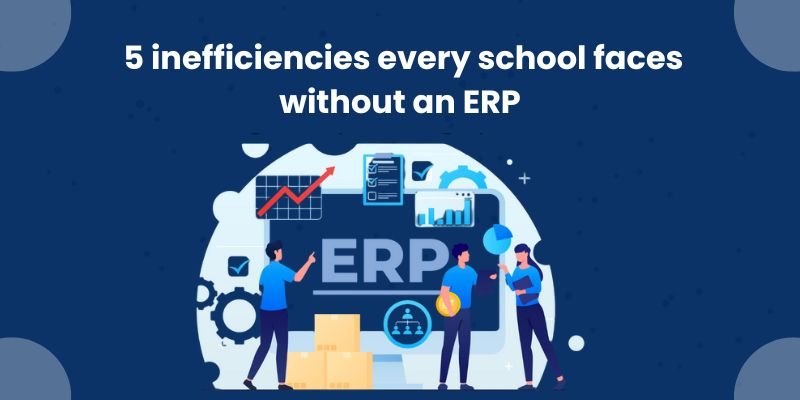In today’s fast-paced educational landscape, the pressure on school leaders to manage operations efficiently while ensuring high-quality education is greater than ever. Yet, many institutions still rely on outdated methods that create operational roadblocks. An Enterprise Resource Planning (ERP) system offers a comprehensive solution to these challenges, but without it, schools face five key inefficiencies that can hamper progress and innovation.
1. Overwhelming Manual Processes
One of the most significant challenges for schools is the continued reliance on manual processes. From administrative paperwork to tracking student records, the absence of an automated system means tasks are time-consuming and prone to errors. Imagine a scenario where every enrollment, fee collection, and report generation is handled manually—it’s not only labor-intensive but also inefficient. In an era where every minute counts, digital automation through ERP can streamline these tasks, allowing educators and administrators to focus on what truly matters: enhancing student learning and engagement.
2. Fragmented Data Management
Data is the backbone of any successful organization. However, without a centralized system, schools often struggle with fragmented data management. Critical information—whether it’s academic records, financial data, or attendance logs—ends up scattered across multiple platforms. This lack of integration makes it difficult to obtain a comprehensive view of the school’s performance. With an ERP in place, all data converges into a single, reliable source, enabling real-time insights and informed decision-making. School leaders can quickly identify trends, address challenges, and optimize resource allocation with confidence.
3. Communication Breakdown
Effective communication is key to any thriving institution. In many schools, however, communication occurs through a patchwork of emails, phone calls, and paper memos. This disjointed approach often leads to miscommunication, delayed responses, and ultimately, inefficiencies that affect daily operations. An ERP system centralizes communication by providing a unified platform where all stakeholders—teachers, staff, and even parents—can stay connected. This integration not only improves clarity and transparency but also ensures that important updates and information reach everyone promptly.
4. Inefficient Inventory & Resource Management
Consider the challenge of managing school supplies, classroom equipment, or even facility maintenance without a streamlined system. Manual tracking of inventory can lead to over-ordering, shortages, and a general mismanagement of resources. The financial implications are significant, with resources being wasted on redundant purchases or emergency fixes. With an ERP system, schools can automate inventory tracking, ensuring that resources are optimally managed and cost-efficient. Real-time data allows for proactive planning and reduces the risk of unexpected shortages, ultimately contributing to a smoother operational flow.
5. Slow Adaptation to Change
The educational sector is constantly evolving, with new regulatory requirements, teaching methodologies, and technological advancements emerging regularly. Schools without a robust ERP system often struggle to keep up with these changes. The reliance on manual processes and fragmented data means that adapting to new trends or regulatory shifts becomes a slow, cumbersome process. On the other hand, an integrated ERP system provides agility. It allows school leaders to quickly pivot, adapt their processes, and stay ahead of the curve. In a competitive educational environment, this responsiveness can be the difference between being a laggard and a leader.
Bridging the Gap with ERP
The move toward digital transformation in education is not just about adopting new technology—it’s about reimagining the entire administrative framework. An ERP system isn’t merely a tool; it’s a strategic enabler that transforms how schools operate. By addressing the inefficiencies mentioned above, ERP solutions empower school leaders to make data-driven decisions, foster better communication, and manage resources effectively.
Imagine a school where every process is interconnected, where real-time insights allow you to anticipate challenges before they escalate, and where the administrative burden is significantly reduced. This is the promise of an ERP system—a future-ready approach that redefines efficiency in education.
Why Now Is the Time for Change
For principals and school administrators, the decision to implement an ERP system is both strategic and transformative. It’s about taking control of your school’s operations, ensuring that every decision is supported by accurate data, and creating an environment where innovation can flourish. The digital revolution in education is already underway, and those who embrace change today will be the leaders of tomorrow.
Transitioning to an ERP system may involve initial challenges such as investment costs and training requirements, but the long-term benefits far outweigh these hurdles. Enhanced efficiency, improved data integrity, and streamlined communication are just the beginning. Ultimately, an ERP system is about building a resilient, agile, and future-ready institution.
A Call to Action for School Leaders
If you’re a school leader committed to excellence, now is the time to reimagine your institution’s operational framework. Begin by assessing your current systems and identifying areas where inefficiencies are holding you back. Engage with your team to understand their pain points and explore how digital transformation can address these challenges.
The challenges of manual processes, fragmented data, communication gaps, inefficient resource management, and slow adaptability are significant obstacles that many schools face without an ERP system. Embracing digital transformation isn’t just a technological upgrade—it’s a strategic shift that empowers educational institutions to thrive in today’s fast-paced world.
Let’s build a future where our schools are not only centers of learning but also models of efficiency and innovation. The journey to transformation begins with a single step—are you ready to take it?












